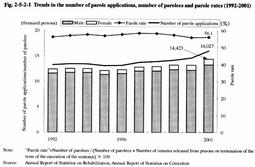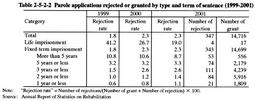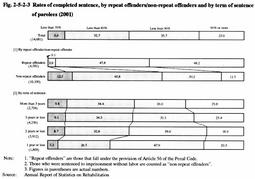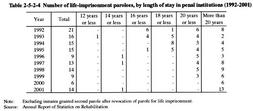| Previous Next Index Image Index Year Selection | |
|
|
2 Administration of parole Fig. 2-5-2-1 shows the trends in the number of inmates whose parole applications were received, the number of parolees and the parole rates since 1992 (see Appendix 2-12 ).
Fig. 2-5-2-1 Trends in the number of parole applications, number of parolees and parole rates (1992-2001) (1) Number of parole applications received The number of parole applications received had been steady within the range of 13,000 or over but below 13,500 since 1992, but increased to 13,745 in 1997. Since then, it has been significantly increasing, and it reached 14,179 in 1999 and rapidly increased by 1,402 from the previous year to 16,027 in 2001.
In recent years, no applications have been received for provisional release of penal detainees or workhouse detainees, or provisional discharge of women in women's guidance homes, with the sole exception of 1 detainee granted provisional release in 2000. There was no such detainee in 2001. (2) Number of parolees and parole rate In 2001, the number of parolees increased by 1,167 from the previous year to 14,423. Recently, the parole rate has been within the range of 56% or over but below 59%. It increased by 0.2 points from the previous year to 56.1 % in 2001.
(3) Rate of rejection of parole application Table 2-5-2-2 shows the rates of rejection of parole applications over the last 3 years with respect to sentences other than indeterminate sentence, by term of sentence. The rates of rejection are high for life imprisonment with 19.0% and imprisonment for more than 5 years with 8.7% in 2001.
Table 2-5-2-2 Parole applications rejected or granted by type and term of sentence (1999-2001) (4) Rate of completed term of execution of sentence for parolees Fig. 2-5-2-3 shows the rates of the completed term of execution of the sentence (percentage of the original sentence actually served until release on parole) for inmates granted parole in 2001 (except inmates serving indeterminate or life imprisonment sentence), by repeat offender/non-repeat offender and term of sentence. In the comparison between repeat offenders and non-repeat offenders, the rate of the completed term of execution of the sentence is lower for the latter.
Fig. 2-5-2-3 Rates of completed sentence, by repeat offenders/non-repeat offenders and by term of sentence of parolees (2001) Table 2-5-2-4 shows the number of inmates serving life imprisonment sentence who were granted parole over the last 10 years, by length of stay in penal institutions.Table 2-5-2-4 Number of life-imprisonment parolees, by length of stay in penal institutions (1992-2001) (5) Environmental adjustment in the prospective place of next abode after release In order to help offenders in penal institutions and juvenile training schools make a smooth return to society, probation offices carry out environmental adjustment. This involves continuously coordinating with family members and other guarantors as soon as the offenders were admitted to the institutions/schools, and preparing the environment most conducive to the offender's return to society.
In 2001, environmental adjustment was newly carried out for a total of 47,049 offenders, consisting of 39,865 prisoners and 7,184 juvenile training school inmates. As of December 31, 2001, environmental adjustment was being carried out for a combined total of 53,151 offenders (prisoners and juvenile training school inmates) (Source: Annual Report of Statistics on Rehabilitation). |



